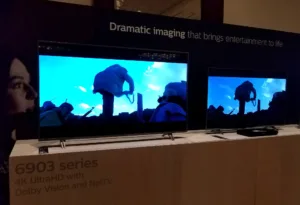The Philips brand in North America is managed in the TV market by Japan-based Funai Electric, which has a US-based subsidiary called P&F USA. When we met with them in the Renaissance meeting room at CES 2018, we were first given an introduction to a new image processing technology from Funai. Called I3C, the technology is an enhancement technique for SDR content that is supposed to rival HDR content.
While the explanation of how it worked was difficult to understand, but the side-by-side demo seemed more compelling. The SDR images with the I3C processing were compared to an HDR image. We were told we were looking at a 300 cd/m² SDR image and an 1800 cd/m² HDR image, but that seems hard to believe as the luminance looked similar to my eye.
There were some noticeable processing and quality differences in the images and in many scenes the I3C processed image actually looked better. The sparkle of glints from waves were enhanced, for example and the texture of sand seemed finer.
This appears to be an interesting technology but we have to remain skeptical because of the lack of clear explanations and language difficulties.
Plans to Support Technicolor HDR
In TVs, Philips announced that they will be the first TV brand to integrate decoding of the Philips/Technicolor developed HDR system into their TVs in 2018. Called Advanced HDR by Technicolor, it will be included in conjunction with the launch of the new over-the-air broadcast standard, ATSC 3.0.
Advanced HDR by Technicolor was recently elevated to a “proposed standard” by ATSC 3.0. The standard calls for the distribution of content in an SDR 10-bit format with dynamic metadata. This is ignored by devices that do not have a decoder, but can recreate the HDR signal using the metadata for capable sets. This is a single stream solution that is not quite backward compatible as it is 10-bit and SDR content is 8-bit.
Trial broadcasts of ATSC 3.0 are expected to start in the US and Korea in 2018. The decoding will also work for content delivered over RF cable/telco networks too. Philips anticipates that sports content will be some of the first to be broadcast in Advanced HDR by Technicolor.
Moving out into the booth, besides the addition of Advanced HDR by Technicolor, Philips is continuing with Dolby Vision support with eight new models over two series in 2018. For the US market, only LCD, no OLED TVs will be offered, although Dolby Vision OLED TVs will be sold in other regions. (for more on the HDR developments, see Advanced HDR by Technicolor Develops)
The Philips NetTV platform has been upgraded a bit too to add Hulu to Netflix, YouTube, Vudu and Pandora. Also new is the NetTV+ App store and the Hotlist and Zumo app portals which can provide free access to over 100 channels of streaming content from such networks as Bloomberg, CBS News, Time, Conde Nast Entertainment, BuzzFeed, PopSugar, and more. It also provides a full web browser.
The color gamut of the 69 series is said to be 75% of BT.2020. The 57 and 59 series drop the wide color gamut, however. The 69 series moves to what they call BrightPro 2 backlight which boosts zone brightness by 30%.
The step down 59 series includes Dolby Vision by dropping the zone dimming brightness to BrightPro, so less bright. The entry level 57 series drops the NetTV feature as well as Dolby Vision support.

